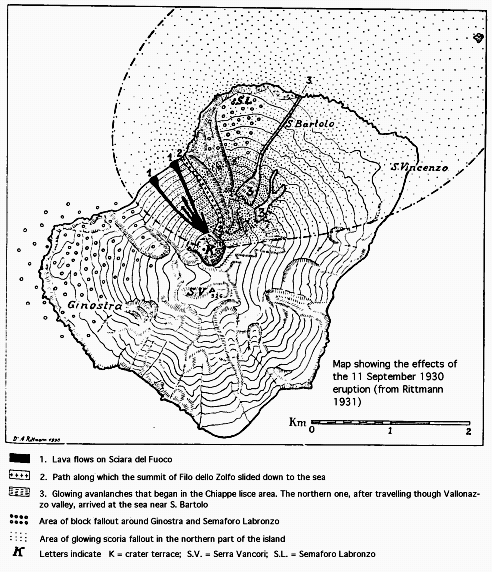| Stromboli
home page |
||
| Geography | Geological Evolution | Eruptive history |
| Volcanic Hazards | References | Web sites |
The 1930 eruption of Stromboli
 Map showing the distribution of eruptive products from the 11 September 1930 eruption of Stromboli (after Rittmann 1931). |
| |
The eruption of 11 September 1930 stands as the most violent and destructive event in the historic record of Stromboli's activity. There was no apparent warning except somewhat increased ash emissions less than two hours before the onset of highly explosive activity; during the preceding months, the activity had been "normal". The eruption lasted less than one day and caused considerable damage as well as several deaths (Rittmann 1931 reports six persons killed).
The phase of unusually intense activity began with a series of powerful ash emissions at 0810 that caused light ash falls in the SW part of the island. This activity lasted only 10 minutes after which normal conditions returned. At 0952, there occurred two extraordinarily strong explosions that blasted old rock fragments over the northern and southwestern parts of the island. During this phase, the conelets within the craters and part of the tephra ramparts around the craters were destroyed. Large blocks (some with volumes of more than 10 cubic meters) destroyed 14 houses in Ginostra and severely damaged the building of Semaforo Labronzo.
This was followed by the ejection of large quantities of highly inflated incandescent scoria which covered all of the summit area. Due to the rapid accumulation on the steep upper slopes, the hot tephra began to slide down as glowing avalanches on the northeastern flank of the volcano, which is, outside the area protected by the high walls surrounding Sciara del Fuoco. The larger of two avalanches rushed down to the sea immediately north of S. Bartolo, along a deep valley called Vallonazzo, and killed four fishermen who were in a boat off the coast. Heavy ash and lapilli fall left a deposit 10-12 cm thick in the village of Stromboli.
During the violent ejection of glowing spatter, a tsunami with runup heights of about 2 m was observed on the island, further contributing to the amount of damage and killing one person.
Explosive activity subsided notably after 1040, and the volcano entered in an effusive stage. Two larger and several smaller lava flows ran down the Sciara del Fuoco, the two larger ones arriving at the sea. Lava emission ended sometime during the night, about 15 hours after the beginning of the eruption.
Were a 1930-size eruption to occur today, on a warm early September night, it would be absolutely lethal to tens of tourists sleeping in the summit area. These unfortunate persons would be subjected to a dense fall of incandescent, large-size clasts (enough to form a continuous sheet in the summit area). During daylight, numerous persons would stay on and around the beach at Piscità, at the NE end of the village of Stromboli, in the area where the largest glowing avalanche entered the sea in 1930. Damage in the villages on the island would be serious. The "Osservatorio", a popular pizzeria with a good view of the volcanic activity at Punta Labronzo, would be in the area of heaviest block fallout.
Stromboli has produced no eruptive event on the scale of the 1930 eruption, but a similar eruption occurred in 1919, and there are good reasons to assume that similar events will occur in the future. The largest problem with "larger-than-normal" eruptions is that until now no clear precursory phenomena have been identified. From eyewitness descriptions of strong explosions at the volcano in the past it appears that all had a very sudden onset. In the case of a 1930-type eruption there would probably absolutely no warning. This was illustrated in an impressive manner when the strongest explosion since 1930 occurred on 5 April 2003, at a time when access to the volcano was forbidden
The problem of volcanic hazards on Stromboli will be discussed in more detail on a separate page.
Copyright © Boris Behncke, "Italy's Volcanoes: The Cradle of Volcanology"
